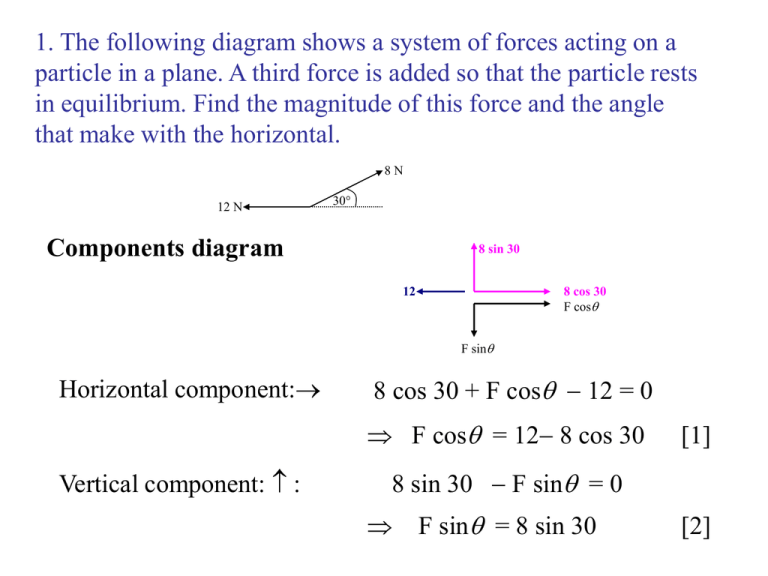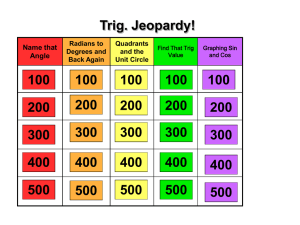Practice questions
advertisement

1. The following diagram shows a system of forces acting on a particle in a plane. A third force is added so that the particle rests in equilibrium. Find the magnitude of this force and the angle that make with the horizontal. 8N 12 N 30 Components diagram 8 sin 30 12 8 cos 30 F cos F sin Horizontal component: 8 cos 30 + F cos 12 = 0 F cos = 12 8 cos 30 Vertical component: : [1] 8 sin 30 F sin = 0 F sin = 8 sin 30 [2] Divide [2] by [1]: F sin 8 sin 30 F cos 12 8 cos 30 tan 4 0.7887 5.0718 = 38.3 Sub into [2]: F sin 38.3 = 4 F = 6.45 N Added force is 6.45 N, acting at an angle of 38.3 below the horizontal. 2. A particle is acted on by a force of 15 N which acts on a bearing of 020º, and another force of 4 N which acts on a bearing of 230º. Find the magnitude of a third force which will keep the system in equilibrium, stating the angle of its line of action as a bearing. Let the third force be P N acting at θ to the horizontal, as shown. The force diagram is: North 20º 230º 4N θ PN Components diagram 15sin70 4 cos 40 Pcos θ 15cos70 4 sin 40 Psin θ 15 cos 70 – P cos θ – 4 cos 40 = 0 (1) (2) From (1): 15 sin 70 – P sin θ – 4 sin 40 = 0 P cos θ = 15 cos 70 – 4 cos 40 From (2): P sin θ = 15 sin 70 – 4 sin 40 (4) Horizontally: Vertically: (4) divided by (3) tan 5.5777 (3) 79.8 Substitute into (3) P = 11.7 N P acts on a bearing of 190º and has size 11.7 N 3. The diagram shows a particle suspended from a horizontal beam by two unequal, light and inextensible strings. Given that the tension in the left string is 8 N and it makes an angle of 40º to the beam, and the other string makes an angle of 60º to the beam, find the tension in the other string and the mass of the particle. 40 60 40 Force diagram 60 T 8N 60 40 Mg Components diagram 8sin 40 T sin60 T cos60 8cos 40 Mg Resolving horizontally:T cos60 8cos40 0 (1) Resolving vertically: 8 sin 40 + T sin 60 – Mg = 0 (2) T cos 60 8 cos 40 0 Resolving horizontally: Resolving vertically: 8 sin 40 + T sin 60 – Mg = 0 From (1): T 8cos 40 12.3 N cos 60 The tension in the other string is 12.3 N Substitute in (2): M 8 sin 40 T sin 60 g 1.61 kg The mass of the particle is 1.61 kg. (1) (2) 4. A car of mass 1500 kg is broken down on a rough plane inclined at an angle of θ° to the horizontal, where sin-1 = (7/25). It is being pulled up the plane by means of a towrope, which is acting at 9º above the line of greatest slope of the plane. The resistance between the plane and the car has a magnitude of 1000 N. The car is at rest in equilibrium and is about to move up the plane. Find the tension in the towrope and the magnitude of the force of the plane on the car. Force diagram T R 1000N 9º 1500g Components diagram Rn T sin9 T cos9 1000 1500g sin 1500g cos Res parallel: T cos9 – 1000 – 1500g (7/25) = 0 T = 5180 N Res perpendicular: Rn + 5100 sin9 – 1500g (24/25) Rn= 13300 N 5. A light inextensible string has its ends attached to two fixed points A and B. The point A is vertically above B. A smooth ring R of mass m kg is threaded on the string and is pulled by a force of magnitude 3N acting upwards at 400 to the horizontal. The section AR of the string makes an angle of 300 with the downward vertical and the section BR is horizontal (see diagram). The ring is in equilibrium with the string taut. (i) Find the tension in the string. A 2N 30 (ii) Find the value of m. B R 45 mg kg Components diagram T sin 60 2 sin45 T cos60 2 cos45 T mg Resolve Horizontally: T + T cos 60 = 2 cos 45 T = 0.942809 .. Resolve vertically: T sin 60 + 2 sin 45 = mg m = 0.228 kg (a) T = 0.943 N (b) m = 0.228 kg








